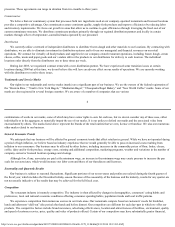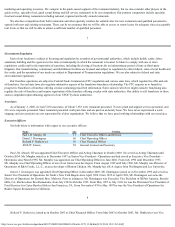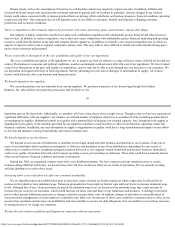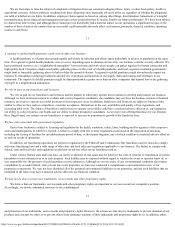Einstein Bros 2005 Annual Report Download - page 16
Download and view the complete annual report
Please find page 16 of the 2005 Einstein Bros annual report below. You can navigate through the pages in the report by either clicking on the pages listed below, or by using the keyword search tool below to find specific information within the annual report.
http://www.sec.gov/Archives/edgar/data/949373/000110465906016136/a06-3178_110k.htm[9/11/2014 10:13:03 AM]
Other expense (income)
(312)
(284)
(172)
(322)
131
Loss before income taxes
(14,018)
(17,454)
(72,709)
(44,528)
(21,586)
Provision (benefit) for state income taxes
—
(49)
812
366
167
Net loss
(14,018)
(17,405)
(73,521)
(44,894)
(21,753)
Dividends and accretion on Preferred Stock
—
—
(14,423)
(27,594)
(58,520)
Net loss available to common stockholders
$ (14,018)
$ (17,405)
$ (87,944)
$ (72,488)
$ (80,273)
Net loss per share—basic and diluted
$ (1.42)
$ (1.77)
$ (22.71)
$ (55.18)
$ (133.43)
19
As of:
Jan 3, 2006 Dec 28, 2004 Dec 30, 2003 Dec 31, 2002 Jan 1, 2002
(in thousands of dollars, except per share amounts)
Balance Sheet
Cash and cash equivalents
$ 1,556
$ 9,752
$ 9,575
$ 10,705
$ 15,478
Property, plant and equipment, net
33,359
41,855
54,513
73,780
98,064
Total assets
130,924
158,456
181,738
203,174
280,203
Short-term debt and current portion of
long-term debt
280
295
2,105
150,872
168,394
Mandatorily redeemable Series Z preferred
stock, $.001 par value, $1,000 per share
liquidation value(3)
57,000
57,000
57,000
—
—
Long-term debt
160,560
160,840
161,120
11,011
12,119
Mandatorily redeemable Series F preferred
stock, $.001 par value, $1,000 per share
liquidation value (temporary equity)(3)
—
—
—
84,932
57,338
Total stockholders’ equity (deficit)
(126,211)
(112,483)
(95,153)
(96,146)
(30,096)
Other Financial Data:
Depreciation and amortization
$ 26,316
$ 27,848
$ 34,013
$ 35,047
$ 18,260
Capital expenditures
10,264
9,393
6,921
5,172
3,757
Number of locations at end of period
626
690
736
747
770
Franchised and licensed
191
237
272
287
287
Company-owned and operated
435
453
464
460
483
Increase (decrease) in comp store sales(4)
5.2%
(1.9)%
(3.5)%
1.9%
2.5%
(1) We have a 52/53-week fiscal year ending on the Tuesday closest to December 31. Fiscal years 2004, 2003, 2002 and 2001 which ended on December 28,
2004, December 30, 2003, December 31, 2002 and January 1, 2002, respectively, contained 52 weeks, while fiscal year 2005, which ended on January 3,
2006, contained 53 weeks.
(2) Interest expense is comprised of interest paid or payable in cash and non-cash interest expense resulting from the amortization of debt discount, notes
paid-in-kind, debt issuance costs and the amortization of warrants issued in connection with debt financings.
(3) As more fully described in the notes to the consolidated financial statements, the adoption of Statement of Financial Accounting Standard (SFAS)
No. 150 resulted in the Series Z Preferred Stock being presented as a liability rather than the historical mezzanine presentation of the Series F.
(4) Comparable store sales represent sales at restaurants that were open for one full year and have not been relocated or closed during the current year.
Comparable store sales are also referred to as “same-store” sales and as “comp sales” within the restaurant industry.
20
ITEM 7. MANAGEMENT’S DISCUSSION AND ANALYSIS OF FINANCIAL CONDITION AND RESULTS OF OPERATIONS
Quickservice Industry Overview
According to the Restaurant Industry Operations Report 2004, published in 2005 by the National Restaurant Association and Deloitte,
quickservice sales growth continues to strengthen fueled by an improving economy. Growth in quickservice restaurant sales outpaced full service
restaurants. Part of the reason for the stronger growth of quickservice restaurants was lessened competition from grocery and convenience stores, as
























